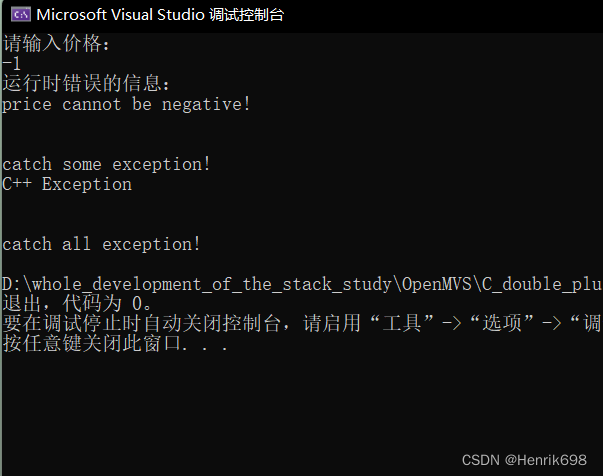C++入门基础06:简单语句与顺序结构、选择结构if与switch、循环语句、跳转语句、异常处理
1、简单语句与顺序结构:
#include <iostream>
//系统定义头文件一般是尖括号
#include<fstream>
#include<string>
using namespace std;
int main()
{
//1、表达式加上分号就是语句
//a + 5
int a = 10;
a = a + 5;
//2、空语句
//while (a > 5); a--; //空语句多余的也不一定是没有害处的
//3、复合语句——语句块
//{ }
{
int b = 6;
b = b + 1;
}
//4、顺序语句
a = a + 5;
a = a * 5;
//....顺序执行
//5、语句作用域
//b是定义在语句块中的,作用域就是该语句块内,外部是没有定义的。
//因此下面的b输出会报错,显示为未定义标识符"b"
//cout << b << endl;
for (int i = 0; i < 10; i++) {
cout << "i:" << i << endl;
}
//cout << i << endl; //这里i的作用域仅限于for循环。
return 0;
}
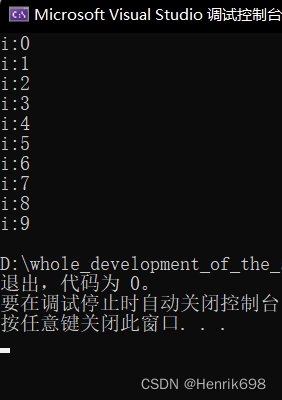
2、选择结构if与switch
#include <iostream>
//系统定义头文件一般是尖括号
#include<fstream>
#include<string>
using namespace std;
int main()
{
//程序流程结构
//顺序结构、条件结构(选择结果)、循环结构
//选择结构:if——else switch——case
//一、 if——else
//if语句
int a = 1;
if (a>6) //bool:true false
{
//不执行
cout << "a 大于 6 !" << endl;
a = a + 5;
}
//if..else
if (a > 6) //bool:true false
{
//不执行
cout << "a的值大于6!" << endl;
}
else {
cout << "a的值小于6:" << endl;
}
//嵌套if语句
if (a > 6) {
cout << "a 的值大于6" << endl;
}
else if (a > 0) {
cout << "a 的值大于0小于6" << endl;
}
else {
cout << "a 的值小于0" << endl;
}
//嵌套的if判断
if (a > 0)
{
if (a > 6)
{
cout << "a大于6" << endl;
}
else
{
cout << "a小于6" << endl;
}
}
//二、switch——case
/*
switch(表达式) //表达式内容只能是字符型或者整型
{
case结果1: 执行语句1; break;
case结果2: 执行语句2; break;
...
case结果n: 执行语句n; break;
default: 执行语句: break;
}
*/
cout << "\n" << endl;
string str = "i like study cplusplus!";
int num = 0;
for (char c : str)
{
switch (c) //表达式内容只能是字符或则整型
{
case 'a': num++; break; //break关键字很重要,不可以遗漏
case 'e': num++; break;
case 'i' : num++; break;
case 'o': num++; break;
case 'u': num++; break;
default: cout << "不是元音字母:" <<c<< endl; break;
}
}
cout << "元音字母个数为:" << num << endl;
return 0;
}
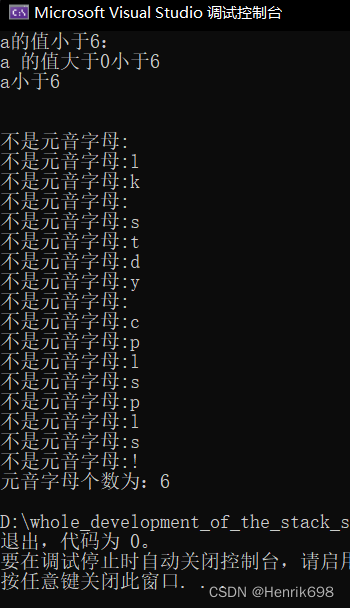
3、循环语句
循环的实现可以使用 for、while 和 do…while 三种形式:
for(初始值;循环结束条件;循环量变更)
{
//代码块
}
范围 for 循环:
for(元素:集合)
{
//代码块
}
范围 for 循环是从集合中取其中的元素,进行循环操作。
while(循环结束条件)
{
// 语句块
}
do
{
// 语句块
}
while(循环结束条件)
注意:do…while 会先执行一次语句块的功能,然后再判断循环条件是否满足。
循环结构要非常注意循环变更是否能满足循环结束条件,不满足则出现死循环。
#include <iostream>
//系统定义头文件一般是尖括号
#include<fstream>
#include<string>
using namespace std;
int main()
{
//1、for 循环
for (int i = 0; i < 10; i++) {
cout << "i:" << i << endl;
}
//2、范围for循环(C++11)
cout << '\n' << endl;
string str = "cplusplus";
for (char c : str) //从str中一个个取字符
{
cout << c << " " ;
}
cout << endl;
//3、while循环
cout << '\n' << endl;
int i = 10;
while (i > 0)
{
cout<<"i的值:"<< i << endl;
i--; //循环变更方法,去掉了就成了死循环。
}
//4、do...while
cout << '\n' << endl;
//先执行一次do,后到while判断
int j = 10;
do {
j--;
cout << "j的值:" << j << endl;
} while (j > 0);
return 0;
}
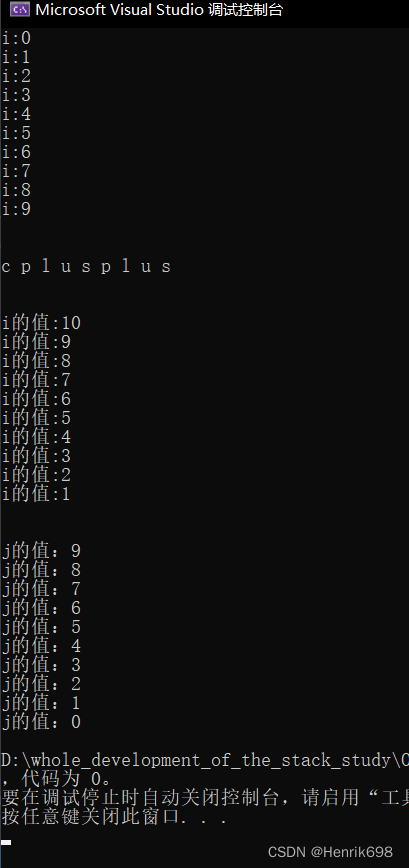
4、跳转语句
#include <iostream>
//系统定义头文件一般是尖括号
#include<fstream>
#include<string>
using namespace std;
int main()
{
//1、break
// 乘法表
// 终止最近的循环,彻底的终止。
//用于switch 和 循环 ( for while do..while)
for (int i = 1; i < 10; i++)
{
for (int j = 1; j <10; j++)
{
if(j>i)
{
cout << endl;
break;
}
cout << i << "*" << j << " = " << i * j << " ";
}
}
//2、continue
// 去除元音字母
//终止当前迭代的最近循环
cout<<'\n' << endl;
string str = "i love study cplusplus very much!";
for (char c : str)
{
if (c == 'a' || c =='e' || c =='i' || c == 'o' || c =='u')
{
continue;
//本次循环结束,不在往下进行了,将
}
cout << c;
}
cout << endl;
//3、return
//返回值
//函数里面使用,在函数章节会做讲解
//4、goto
//无条件跳转,但是不建议大家使用
int a = 0;
label:
int c = 9;
a = a + 1;
goto label; //没有任何条件与意义的进行跳转,不建议使用
int b = 9;
b = b + 1;
return 0;
}
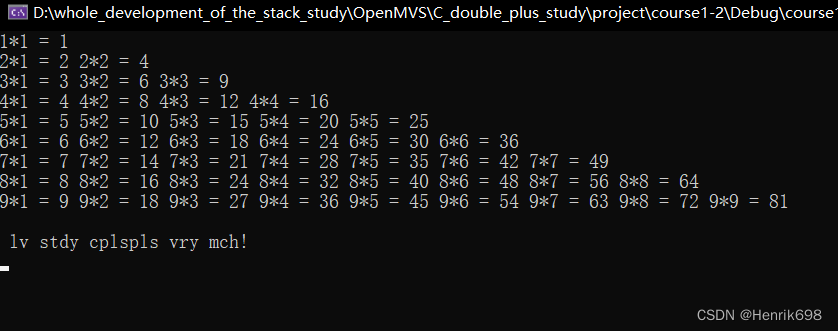
5、异常处理
异常是程序在执行期间产生的问题或者特殊错误,如除以零的操作。
C++提供了异常处理机制,异常处理涉及到三个关键字:try、catch、throw。
try: try 块中是尝试执行的代码,该代码有可能有异常抛出,它后面通常跟着一个或多个 catch 块。
catch: 用于处理程序捕获异常。
throw: 当代码执行出现问题时,可以使用 throw 关键字抛出一个异常。
try
{
// 可能有异常抛出的代码
}catch( ExceptionName e1 )
{
// catch 块
}catch( ExceptionName e2 )
{
// catch 块
}
C++ 提供了一系列标准的异常,定义在 中,我们可以在程序中使用这些标准的异常。
也可以通过继承和重载 exception 类来自己定义异常。
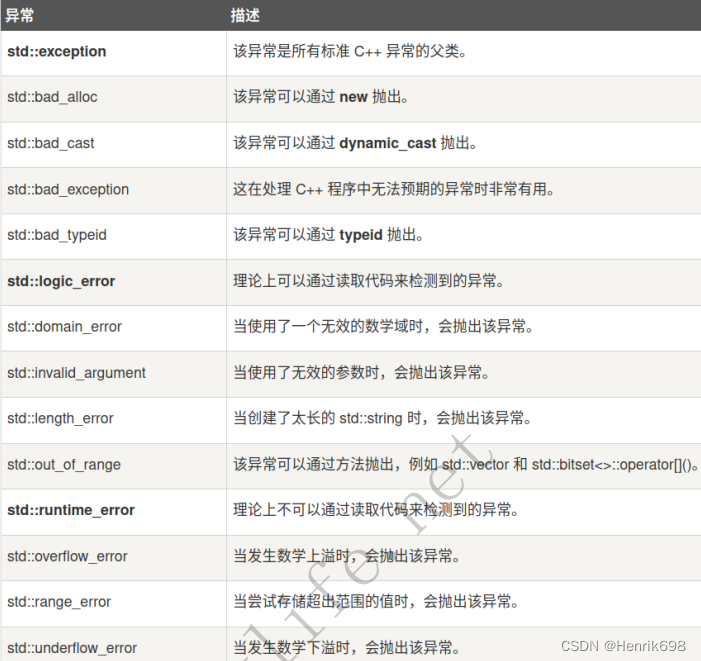
尽量使用标准库的异常
#include <iostream>
//系统定义头文件一般是尖括号
#include<fstream>
#include<string>
#include<exception> //标准库的头文件,标准库的异常
using namespace std;
//异常处理
//自定义了一个MyException异常
struct MyException : public exception //继承exception这个类,也就是标准库的异常。
{
//重写了一下what()函数,在exception中有定义了一个what()函数,重写了一下what()函数的返回信息:
const char* what() const throw()
{
return "C++ Exception";
}
};
int main()
{
int price;
try
{
cout << "请输入价格:" << endl;
cin >> price;
if (price <= 0)
{
//抛出异常
throw runtime_error("price cannot be negative!");
}
}
//catch只捕获运行时异常,运行时异常变量名名称叫e
catch (runtime_error e)
{
//输出一下运行时错误的信息。
cout<<"运行时错误的信息:"<< endl;
cout << e.what() << endl;
}
cout << "\n" << endl;
try
{
throw MyException();
}
catch (MyException e)
{
cout << "catch some exception! " << endl;
cout << e.what() << endl;
}
cout << "\n" << endl;
try
{
throw MyException();
}
//括号中是三个点表示捕获所有异常。
//如果不适用...,那么有可能异常没有捕获到,程序就有可能崩溃,所以为了能够让程序正常运行,使用...去捕获所有异常。
catch (...)
{
cout << "catch all exception! " << endl;
}
return 0;
}
